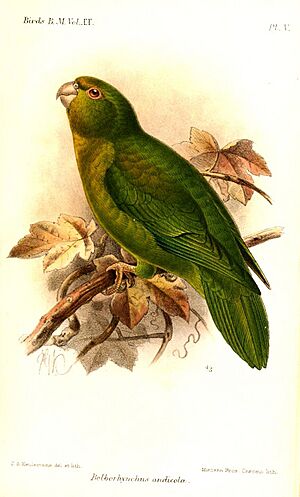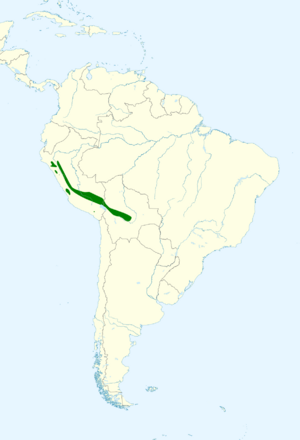Andean parakeet facts for kids
The Andean parakeet (scientific name: Bolborhynchus orbygnesius) is a cool type of bird. It belongs to the parrot family, just like the colorful parrots you might know! These parakeets live in South America, specifically in the Andes Mountains of Peru, Bolivia, and Argentina.
Quick facts for kids Andean parakeet |
|
|---|---|
 |
|
| Illustration by Keulemans, 1891 | |
| Conservation status | |
| Scientific classification | |
| Genus: |
Bolborhynchus
|
| Species: |
orbygnesius
|
 |
|
| Synonyms | |
|
|
Contents
About the Andean Parakeet
What's in a Name?
Scientists sometimes change how they classify animals. The Andean parakeet was once called Bolborhynchus andicolus. It was also thought to be a type of mountain parakeet. Some experts even group it with the rufous-fronted parakeet. But today, it's considered its own unique species.
What Does It Look Like?
The Andean parakeet is about 16 to 17 centimeters (6 to 7 inches) long. It weighs around 48 to 50 grams (1.7 to 1.8 ounces). It's a bit plump with a short tail.
Most of its body is green. Its face and belly have a yellow tint. This yellow is brightest on its throat and upper chest. The outer parts of its wing feathers are a pretty teal color. Sometimes, they even look a bit violet! Its beak is grayish, and its legs are a dull pink. Young parakeets look just like the adults, but they don't have the yellow tint.
Where Does It Live?
You can find the Andean parakeet in the Andes Mountains. Its home stretches from Peru's Cajamarca area. It goes south through central Bolivia. Then it reaches into Argentina's Jujuy and Salta provinces.
These parakeets like places with semi-dry cloudforests. They also live in Polylepis woodlands. You might see them in ravines with lots of bushes. They usually live at high elevations. This is typically between 3,000 and 4,000 meters (9,800 to 13,000 feet). Sometimes, they can even be found above 6,000 meters (20,000 feet)!
Andean Parakeet Behavior
Moving Around
Andean parakeets don't always stay in the same spot. When it's not breeding season, they move to lower valleys. This helps them find food and better conditions.
What Do They Eat?
These parakeets are always looking for food. They search for seeds, fruits, and berries. They find their meals on the ground. They also look in bushes, bamboo, and leguminous trees.
Family Life
We don't know much about how Andean parakeets raise their families. It's been reported that they build their nests in burrows. These burrows are often found in earthen banks.
What Do They Sound Like?
The Andean parakeet has a unique call. It's a short, dull note. They often give it in chuckling pairs or triplets. It sounds like "juh-juh-juh." They can also make a much longer chattering sound.
Conservation Status
The IUCN (International Union for Conservation of Nature) checks on animals. They have listed the Andean parakeet as "Least Concern." This means it's not currently in danger.
It lives across a pretty large area. We don't know exactly how many there are. But experts believe their numbers are stable. No big threats have been found right now. They are common in some places. Sometimes, flocks of up to 300 birds have been seen!


